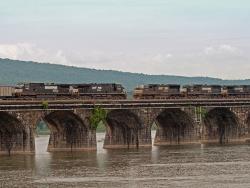According to oral history, George Washington visited the canal diggings in 1792, and then again in 1794, while he was accompanying troops to suppress the Whiskey Rebellion in Western Pennsylvania.
Susquehanna


The third bridge built on the same site to carry railroad tracks across the Susquehanna River just north of Harrisburg, Pennsylvania, the Rockville Stone Arch Bridge, at 3,820 feet long and 52 feet wide, is believed to be the longest and widest stone-arch railroad bridge in the world. A central link in rail travel between New York City and Pittsburgh, the Rockville Stone Arch Bridge accommodates four lines of railroad tracks, today serving both the Norfolk Southern and Amtrak lines.
Innovations

The third bridge built on the same site to carry railroad tracks across the Susquehanna River just north of Harrisburg, Pennsylvania, the Rockville Stone Arch Bridge, at 3,820 feet long and 52 feet wide, is believed to be the longest and widest stone-arch railroad bridge in the world. A central…
Read More
According to oral history, George Washington visited the canal diggings in 1792, and then again in 1794, while he was accompanying troops to suppress the Whiskey Rebellion in Western Pennsylvania.
The Union Canal Tunnel was a crucial structure allowing the connection of the eastern and…
Read More

